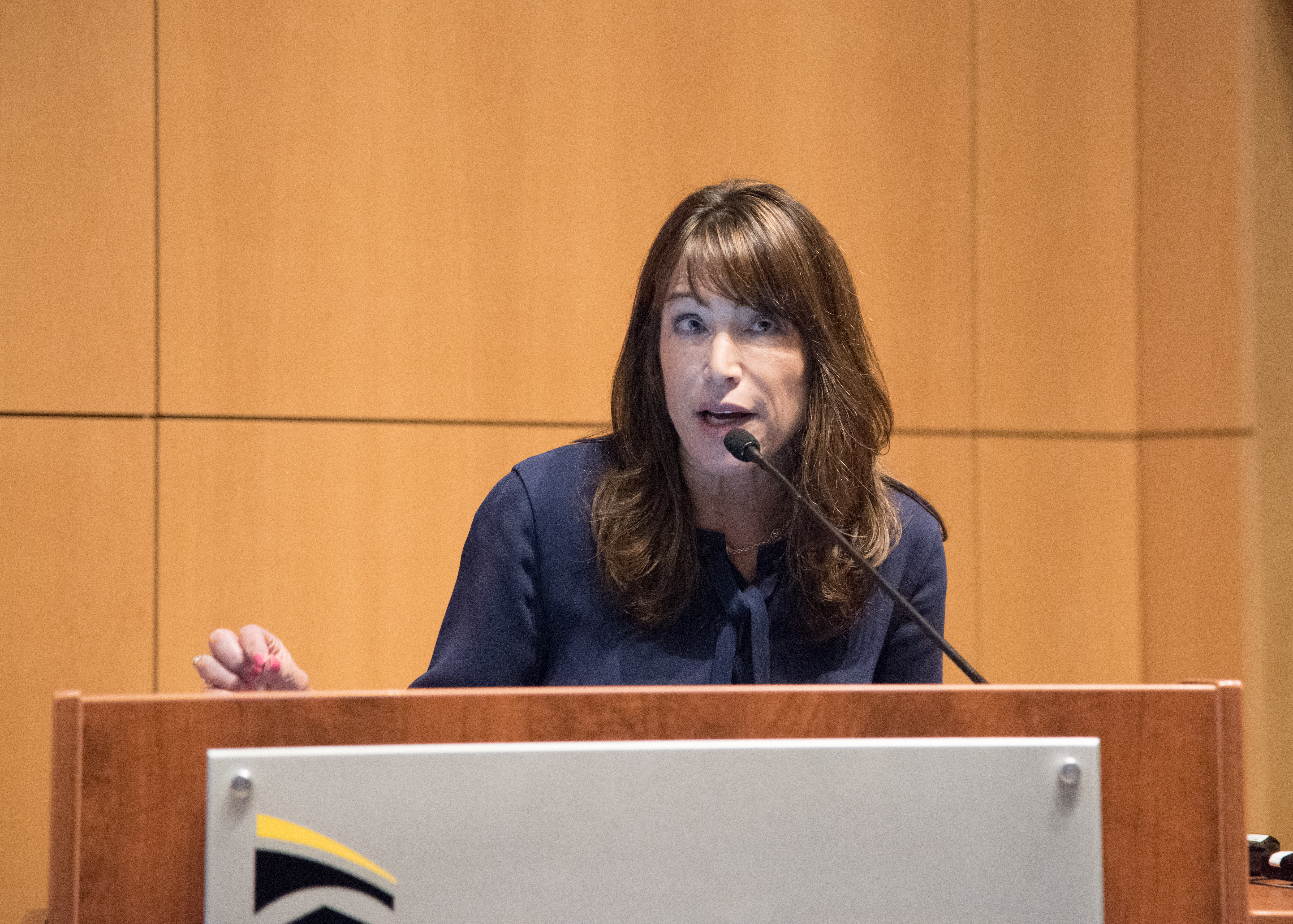Summit Focuses on Improving Health Outcomes
Nurses are an integral part of addressing the nation’s substance abuse epidemic and it all starts with changing the conversation, according to Marla T. Oros, MS, BSN ’84, RN, president of the Mosaic Group, a management consulting firm with expertise in community health.
Oros shared her vision for the tremendous impact nurses can make on combating the substance abuse crisis as the keynote speaker at the 2019 Maryland Action Coalition (MDAC) Summit held May 20 at the University of Maryland School of Nursing (UMSON). The summit’s theme was “Fostering a Culture of Health Where People Live, Work, and Play: Implications for Nursing Education and Practice.”

Marla T. Oros, MS, BSN ’84, RN, president of the Mosaic Group, a management-consulting firm with expertise in community health, addresses attendees at the 2019 Maryland Action Coalition Summit at the University of Maryland School of Nursing.
“We know we do have, obviously, this public health crisis in our country where life expectancy for the first time has declined for two years in a row,” Oros said. “We believe that the drug overdose crisis that is now the No. 1 cause of death is driving a lot of that decrease in life expectancy.”
The national focus is so heavily placed upon the opioid epidemic that use of alcohol and other drugs may be overlooked, Oros said. That’s why she is advocating for a universal screening approach, called SBIRT, in which patients are routinely asked about their alcohol and drug use as a standard part of their visit, similar to a routine blood pressure check. SBIRT stands for Screening, Brief Intervention, and Referral to Treatment.
The SBIRT screening model involves a simple test to determine if a patient is at risk for or may have an alcohol or substance use disorder. In the “brief intervention,” screening results are explained, information is shared on safe use, and assessment is made of the patient’s readiness to change their behavior. Patients with a positive result on the screening are referred for an in-depth assessment or treatment.
“It starts with nurses,” Oros said. “Nurses are the front door to this model, because they do the screening. Our goal is to integrate and sustain these interventions as a routine part of care and practices. We’re really trying to change the conversation. The more we ask, the more comfortable our patients are with us asking and the more we normalize this conversation about asking about drugs and alcohol.”
“I know we all can’t pick up a newspaper these days or turn on a radio without hearing a story about the substance abuse epidemic,” Oros said.
In 2017, there were about 20 million Americans who needed substance abuse treatment, but only one in eight received it, she said, adding, “We have this huge significant gap between individuals out there who need help and those who are getting help.”
MDAC, the state’s arm of the national Campaign for Action, serves as one of the driving forces for transforming health care in Maryland. Recognizing the important work underway in the state and with a goal of improved health outcomes for its residents, MDAC leads innovation in the health of the population through efforts that build and sustain a culture of health. UMSON Dean Jane M. Kirschling, PhD, RN, FAAN, and Patricia Travis, PhD ’88, MS ’76, BSN ’69, RN, CCRP, senior associate director of clinical research, Johns Hopkins University School of Medicine, are the co-chairs of MDAC.
Each year, the summit recaps achievements and opportunities in improving health care services, health outcomes, and minimizing health disparities in Maryland; examines advancements in improving health outcomes for Maryland’s diverse populations and communities; and provides a forum in which to disseminate innovation in practice, education, policy, and research in advancing a culture of health.
More than 120 leaders in nursing education and practice statewide, representing 16 colleges and universities and more than 21 health care entities, attended this year’s event, which included a full-day agenda of panel discussions, podium and poster presentations, and Stop the Bleed training.
In her afternoon presentation, Oros shared statistics illustrating the toll drug and alcohol abuse has taken on the country and the economy. Drug overdose is the No. 1 cause of injury-related deaths in the United States, she said. In Maryland, SBIRT has been implemented in 24 hospital emergency departments, detention centers, labor and delivery, and OBGYN units.
Earlier in the day, representatives of three of Maryland’s hospital systems participated in a panel discussion titled “Maryland Health Care: Advancing the Culture of Health in Our Communities.” Panelists Linda Dunbar, PhD ’05, MS ’98, vice president, Population Health, Johns Hopkins HealthCare; Vickie Ensor Bands, MSN, MSA, RN, director, Community Outreach, University of Maryland Upper Chesapeake Medical Center; and Ryan B. Moran, MHSA, director of community health-Baltimore City, MedStar Health, discussed their organizations’ initiatives aimed at improving population health in the communities they serve.
While Moran touched on MedStar’s efforts related to substance use treatment through an Opioid Survivor Outreach Program, the panel discussion focused on more broadly reaching, holistic approaches to improving population health. “We’re treating the whole person in a very patient-centric intervention,” Dunbar said of the Johns Hopkins Community Health Partnership, a coalition of health care institutions and community organizations aimed at coordinating care for patients who have complex medical and multiple social challenges.
Other population health initiatives the panelists discussed revolved around reducing readmissions, increasing HPV vaccination, creating employment pathways, reducing gun violence, facilitating self-management, and reducing health disparities. Dunbar indicated that social determinants drive 40 percent of health outcomes, and in Baltimore, a discrepancy in life expectancy can reach nearly two decades between certain city neighborhoods.
Registration costs for this year’s summit were subsidized by the University of Maryland, Baltimore’s Maryland Nursing Workforce Center, funded by the Nurse Support Program II, which in turn is funded by the Maryland Health Services Cost Review Commission and administered by the Maryland Higher Education Commission.



